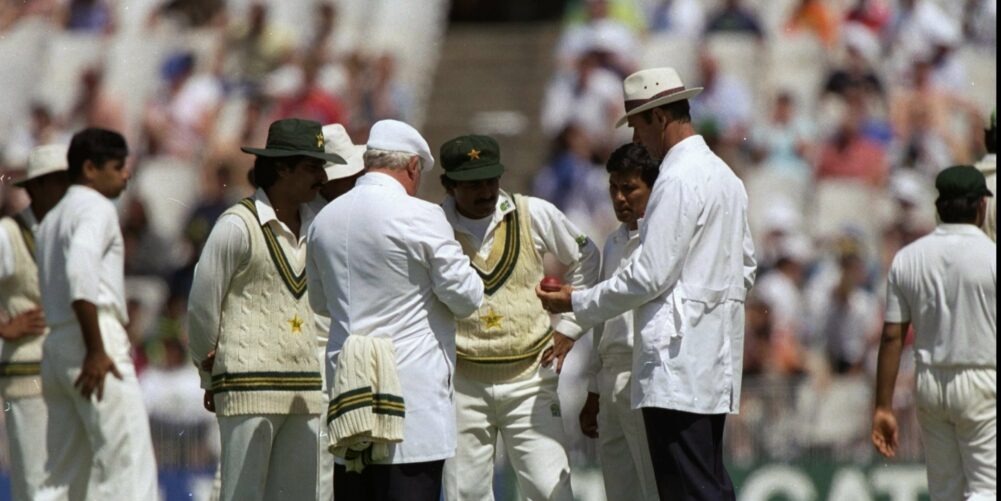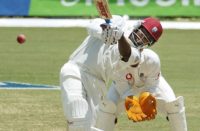Alex Narey looks back on the 1992 Test series that was marred by accusations of ball-tampering…
Sunday, August 23, 1992. It’s lunchtime at Lord’s during the fourth one-day international between England and Pakistan. Chasing 203 for victory, Graham Gooch’s side have reached 140-4, easing towards their target in a game that started more than 24 hours earlier; carrying over a day after heavy rain had swept across the south of England on Saturday. On paper, it’s a nothing contest: a dead rubber with England already in an unassailable 3-0 lead in the five-match limited-overs series… but the script of the summer is not allowing events to be played out in a placid manner.
As the sun beats down in St John’s Wood, umpires Ken Palmer and John Hampshire are inspecting the ball in the officials’ changing room, a cherry that, despite being only 27 overs old, looks like a dog has been mauling it since dawn.
There’s a deep split across the cover, and Palmer and Hampshire, with the approval of the match referee, Deryck Murray, decide a change is needed. Both management teams are made aware, and both management teams are happy with the call. However, in the Press room, the ammunition has been served: Pakistan are cheating again; it’s time to get the knives out…
While Pakistan’s tour of 2006 is remembered for their forfeiting of the third Test at the Oval due to allegations of ball-tampering by umpire Darrell Hair, it was the series that preceded it some 14 years earlier where the cheating tag was first marked. With the tourists, notably Waqar Younis and Wasim Akram, producing late, sharp reverse swing with the old ball as Pakistan won the Test series 2-1, fingers were pointed in the English tabloids, and ball-tampering could be the only possible outcome.
The accusations later spread through the England camp, with a court tussle between former Pakistan seamer Sarfaz Nawaz and Allan Lamb, while the row between Ian Botham and Imran Khan – and Lamb – came to a head in an expensive High Court battle four years later when the former Pakistan captain was cleared of labelling Botham and Lamb racists and ball-tamperers.
The tour had started with Pakistan’s visit to Canterbury to play Kent in early May. This was an era when a ‘summer’ tour was just that. It was a lucrative series for the Test and County Cricket Board (TCCB), with an estimated £7 million expected to be generated from five Tests and five one-dayers. But between landing in Heathrow in April and boarding their return flight 127 days later, the tourists would be splattered across the country’s national papers with an eclectic mix of headlines.
There was, firstly, some sublime cricket to report. Despite two matches being heavily affected by rain, Pakistan were worthy winners in the Test series – at least on paper. They had in their ranks a number of wily campaigners who could navigate the English conditions with skill and intelligence, able to counter attack their way out of trouble with batsmen such as Ramiz Raja and Salim Malik.
There was the 22-year-old leg-spinner, Mushtaq Ahmed, a craftsman and artist in his own right even in the pre-Shane Warne era. There was a hard-nosed leader in Javed Miandad – an abrasive, street-fighting cricketer whom the Pakistan Cricket Board had turned to in the absence of the Oxford-educated Khan, who was unable to make the tour due to injury.

And then there was Wasim and Waqar – Miandad’s pace twins who would prove to play the lead roles in the series. With new ball and old, they combined to take 43 English wickets (21 for Wasim, 22 for Waqar) – a mixture of searing pace and late, reverse swing leaving Gooch’s men perplexed at what they were facing. There were no answers, and when the top-order had been worked over, the ease with which the tail was blown away was reminiscent of paper swirling in the wind.
Even before the tour began, there was an undercurrent of tension between the two sides. The Pakistan tourists of 1987 had endured a number of heated moments with English umpires, especially David Constant and Ken Palmer. Pakistan had been calling for neutral umpires since 1980, while England, for their measure, were still reeling from the Shakoor Rana drama on their winter tour of 1987/88.
But fresher wounds between the players were also evident. The two sides had met in March’s World Cup final in Melbourne, a stormy affair that Pakistan had won by 22 runs. England had been the heavy pre-tournament favourites, and had played some fine cricket in the early stages. Notably, in their group clash with Pakistan at Adelaide, England had routed their opponents for just 74.
But, chasing the paltry total, the heavens then opened and the fixture was abandoned as a ‘no result’ – with both sides taking a point apiece. Inevitably, that single point was enough for Pakistan to squeeze through to the semi-finals at the expense of Australia, and with Imran’s men peaking just as England were flagging in form, the Melbourne showdown proved one game too many; Wasim butchering the middle-order as England stuttered and never recovered in pursuit of 250.
Gooch’s side began to right some of those wrongs with back-to-back one-day wins at Lord’s and the Oval as the International summer got underway, before the limited-over series went into hibernation with the Tests looming. Waqar, who had been forced to sit out the World Cup with a back injury, had also been held back in those early one-dayers. The 20-year-old’s reputation as the world’s finest bowler had been rubberstamped with a hugely impressive 1991 season as Surrey’s overseas player. His 113 Championship wickets had come at a staggering 14.85, and included 13 five-fors and three 10-wicket hauls – the pace and verbal aggression simply too much for many on the domestic circuit.
He was not the only Pakistan seamer who had tasted success in England. Wasim had by now become a key figure for Lancashire, while Aaqib Javed, still only a teenager but with the stare and hostile attitude of a more-seasoned campaigner, had built a fine reputation during a single season with Hampshire the year before.
But while 1991 had been a season of success for these bowlers, there had also been murmurings of the dark act of ball-tampering. Nothing was ever proved or even officially contested, but a bed had been made and it would give the media plenty to work with for their column inches some 12 months later. That said, it was a three-pronged attack any cricket lover would pay to watch, and it was Waqar who was the early headline act, especially after Wasim had been ruled out of the opening Test match at Edgbaston.
Both sides cancelled each other out in Birmingham on a flat pitch, but the series came alive at Lord’s for the second Test. Wasim now back in the fold and with Waqar cutting through England with 5-91 the hosts were dismissed for 251 in the first innings.
Though England fought back, restricting Pakistan to 291 in reply, a blistering Sunday spell from Wasim during England’s second dig meant the tourists were chasing only 140 for victory. They fell away early, but came through in the end with the new-ball pair that had done the early damage seeing the tourists home with a 46-run partnership to seal the two-wicket win.
Such was the devastation of England’s second-innings collapse on that Sunday afternoon at Lord’s – as they fell away from 73-2 to 175 all out – that the story of victory was now littered with the story of cricketing malpractice. Indeed, the English media seemed less concerned with the damage Pakistan had inflicted with the ball, and more concerned with the damage they were doing to it when in the hands of their fieldsmen and, more pointedly, the side’s two premier fast bowlers.

Though there were no verbal accusations from the players, the Press had sown their seed, and they had another target, all be it via a different channel, during the third Test at Old Trafford.
After racking up 505 in their first innings, Pakistan were able to attack, but when England avoided the follow-on, and with rain lurking at almost every corner, the game was fizzling away towards a draw. Heading towards the close of the fourth day’s play, Aaqib, once again displaying a level of menace that had brought him little popularity from opposing batsmen, proceeded to bombard England’s No. 11, Devon Malcolm, with a series of well-directed bumpers.
Warned and asked to tone his actions down by umpire Roy Palmer, Aaqib continued to bounce his bunny, and then became embroiled in a jumper tug-of-war with the lanky official at the end of the over. It was an incident where Palmer may have come across as someone who had forgotten his position as a neutral man, but there was little excuse for the tourists’ behaviour as, led by Javed, they rounded on the official.
Aaqib would lose half of his match fee as a result, before England fought back in the fourth Test on a seaming deck that, even by Headingley’s heyday standards, was juicy to the extreme.
It set the fifth Test up as the decider, which the tourists won in just over four days. After Wasim had ripped through England’s tail to finish with 6-67, Waqar produced what he hailed as his finest spell of the summer, nailing England’s batsmen on the crease during his 5-57 in their second innings.
Again the bowlers were forced to fend off a vitriolic media reception in the wake of victory, with Wasim in particular vocal in hailing the art of reverse swing as, well, just that – an ‘art that required much practice and great skill’.
But his cries of innocence did little to stop the barrage, and as the tour sailed on uneasy waters towards its climax with the one-day series still to be concluded, the Independent’s Martin Johnson summed up the mood of unrest, saying: “As far as Pakistan are concerned, cricket in England is run by arrogant racists. As far as England are concerned, Pakistan cheat. Today, the two countries are as far apart as ever.”
As for that one-day clash at Lord’s, when the umpires had taken the decision to change the damaged ball, it was to prove a badly managed incident by both the TCCB and ICB (International Cricket Board), who refused to release the report to the media.
Rather than openly declaring that the ball had been changed due to its condition and for losing its shape, the lack of explanation left the matter open to interpretation, creating more bad Press than good.
And the irony, even with the changed ball? Pakistan still turned a likely defeat into victory, reducing England’s tail to dust with the last four wickets falling for ten runs as they won by four runs.
While it is all too easy to surmise that events in 2006 – and latterly 2010 with the spot-fixing scandal – have led to some justification for Pakistan’s critics, it should be noted that the tourists set the benchmark for a cricketing skillset that the world has been striving to reach ever since.
In 2005, England were themselves hailed as the masters of reverse swing after beating Australia, whose batsmen were as equally flummoxed as England’s had been some 13 years before.
Speaking during that summer as Andrew Flintoff led England’s old-ball charge against against their Antipodean rivals, Wasim himself would have no doubt felt a sense of redemption, but highlighted that the wounds still needed to be healed: “England owe us an apology in a big way,” he said.
“When we did the reverse swing in 1992, England were the great moaners and groaners of the game. And now they have achieved an Ashes win through reverse swing.
“It is an art. We never got the credit we deserved.”
This piece originally featured in The Cricket Paper on Friday October 9, 2015















